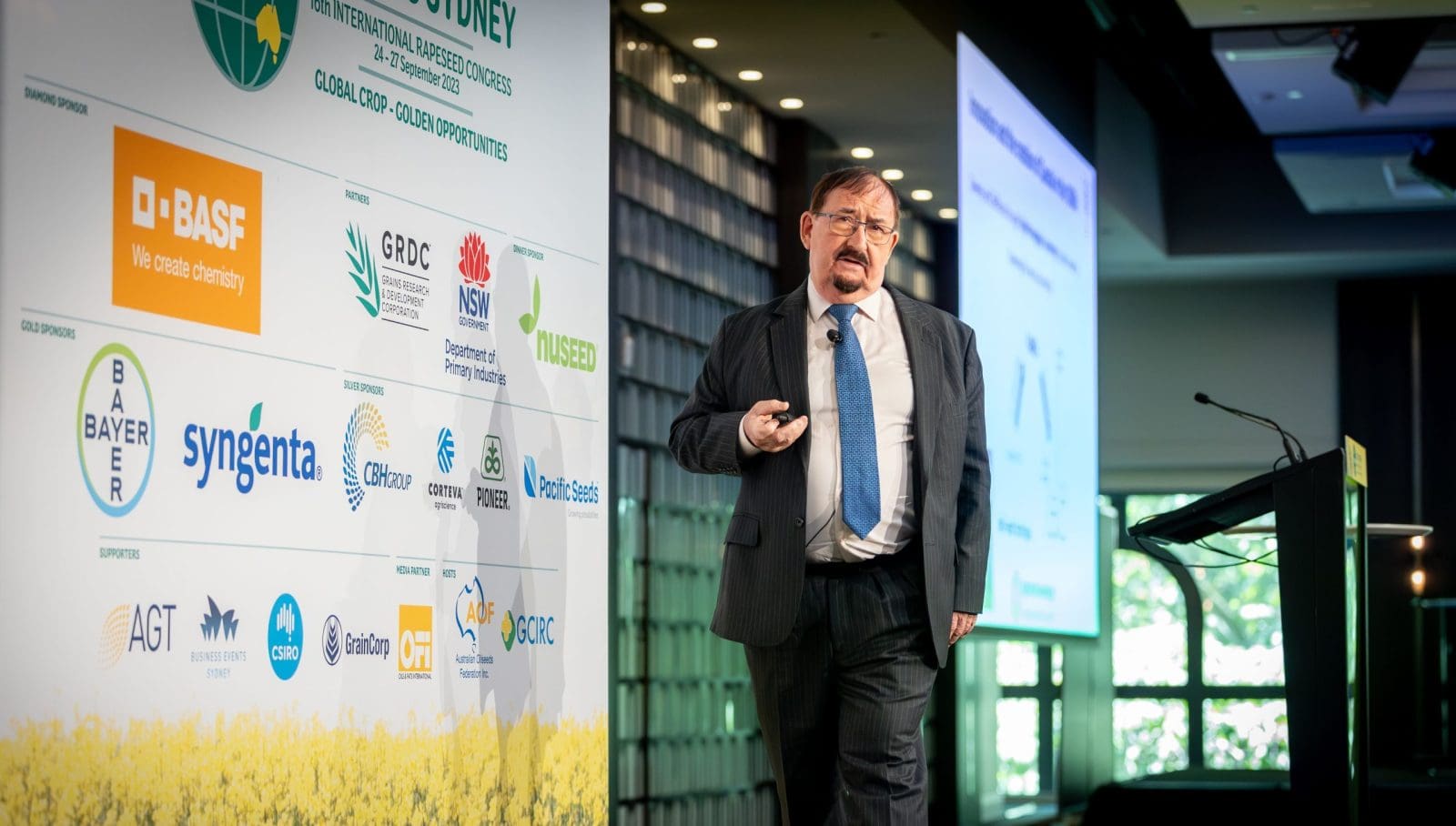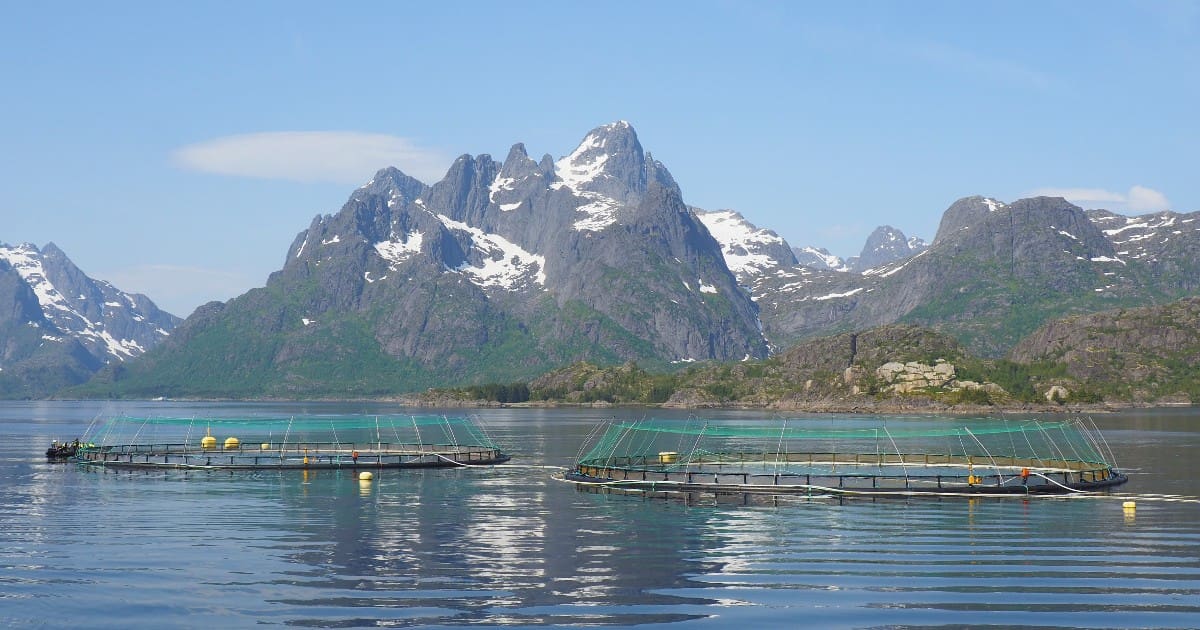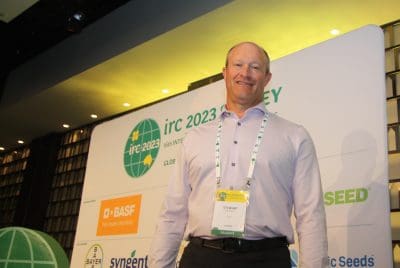
AgritecKnowledge founder and managing partner Maurice Moloney addresses the International Rapeseed Congress held this week in Sydney. Photo: IRC2023
BE IT RAPESEED in Europe and Asia, or canola in Australia and Canada, the oilseed’s future direction appears closely aligned to patents around seed technology, and the course industry and governments plot to a net-zero future.
It includes potential for the crop and its relatives as a biofuel of significance, a topic touched on by Canadians BASF global head of oilseed breeding Stewart Brandt and AgritecKnowledge founder and managing partner Maurice Moloney in their addresses at the 16th International Rapeseed Congress.
Being held this week in Sydney, the forum has attracted 530 delegates from 31 different countries to examine the latest in research and development for the yellow-flowered oilseed which has revolutionised farming for many growers in Australia and Canada, with its genetic modification playing a key role.
The technology has given canola herbicide tolerance, shatter-resistant pods, and some stellar yield gains, while traditional breeding has developed disease resistance and other desirable agronomic traits in GM and non-GM varieties.
As Mr Moloney explained, a development by Nuseed and CSIRO has through genetic manipulation produced a canola which yields omega-3 oil now approved for use in Norway as feed for farmed salmon.
While the EU still appears to be a long way from allowing GM breeding programs for rapeseed, the approval is seen as a recognition of the role of GM oilseeds in producing crops with health and environmental benefits to fit with the congress theme of Global crop – golden opportunities.
From industrial to food, feed
Polish rapeseed was first planted in Canada in the 1930s, and its ability to stick to hot surfaces turned it into an important engine lubricant for the Allies’ steam-powered Liberty ships fleet of World War II.
Mr Moloney said after the war, canola oil found a fan base in Japan, where its high smoke point made it the preferred medium for frying tempura, the start of its journey as a valuable human food.
Now oil from a GM line developed by CSIRO and Nuseed with properties akin to those of fish oil rich in omega-3 has been approved in the Aquaterra feed supplement for use in aquaculture in Norway.
This follows Aquaterra’s approval with the US Food and Drug Administration.
“This is synthetic biology in reality,” Mr Moloney said.
“The result has been to create oils that absolutely replicate the profile of fish oil.”
Mr Moloney said the oil “is basically breaking through in regulatory systems”.
“Europe has been rather allergic to GM for some time.”
He said the approval will bring a new attribute to fish produced through aquaculture.
“All that farmed salmon you buy in the supermarket will more closely resemble wild-caught fish.”

Oil from a GM canola developed by CSIRO and Nuseed has been approved for use in salmon farms in Norway. Photo: Nuseed Global
It is the latest iteration of canola as feed, made possible through breeding when rapid screening in the late 1960s and early 1970s targeted low-glucosinolate rapeseed so meal did not taste hot “like wasabi or mustard” to livestock.
Along with improved agronomic traits, it saw canola become a leading crop on Canada’s Prairies.
“We went from a few thousand acres to 5Mha grown on the prairies; from a point of view of adoption, that was quite remarkable.”
Next stage for emissions reduction
Mr Moloney said canola facilitated the switch to no-till farming through its herbicide tolerance as a hugely important reducer of emissions from farming, and the use of brassica varieties as a cover crop and a source of biofuel could be just as significant.
He said brassica carinata could be double cropped as a means of sequestering carbon, Rothamsted Research in the UK was doing parallel research with camelina, and pennycress, or Thlaspi arvense was being investigated as a cover crop and biofuel source.
He said the US company Yield10 was using camelina sativa “in much the same way”, and that brassica research generally held promise to produce a sustainable aviation fuel.
“Nobody’s changing the design of the jet engine any time soon.”
Mr Moloney said brassicas research was “right at the cutting edge of what we need to be doing for a net-zero future.”
Startling growth since 1970s
Mr Brandt took the audience through canola’s growth in Canada, where it covered 1-3 million hectares (Mha) in the 1970s.
That swelled to 3-4Mha in the 1980s and got to 6Mha in the 1990s and 2000s, when the specialty oil market grew and resistance to the blackleg disease had been achieved.
In the 2010s, productivity continued to increase due to high-yielding hybrids with greater resistance to pod shattering, enabling growers to further improve their bottom line by direct heading instead of swathing.

BASF head of global oilseed breeding Stewart Brandt.
Between 2010 and 2015, Canada’s canola area grew to 7-9Mha, and since 2016, it has settled in the 8-9Mha range as yield became more stable.
“In 2017, canola plantings exceeded wheat plantings for the first time in Canada,” Mr Brandt said.
“Right now in canola, there are so many things for us to be optimistic about, but we still have a lot to do.”
Mr Brandt said pests, diseases and climate variability remained major challenges, and growers across the Atlantic were countering them without GM in their programs.
“European oilseed rape has also developed over the past 50 years but without genetic modification.”
Mr Brandt said prior to herbicide-resistant canola, it was being grown once every four years at its most frequent, and that GM varieties and hybridisation enabled it to become a profitable crop that could attain weed control in the rotation.
“Australia, like Canada, is a major export player…and canola has grown from being a rotational crop to a key part of the farm.”
While Australia and Canada might see some growth in canola area as regions where it can be grown expand, Mr Brandt sees limited growth potential for the crop’s global footprint at present.
Mr Brandt listed the countries of significance in global canola production as: Australia; Canada; China; France; Germany; India; Poland; Ukraine, and the US.
“For the foreseeable future, we do not expect this map to change dramatically.”
He said increasing demand for vegetable oil as food and fuel would support modest growth in the global crop size, with a 1-2pc yield growth per annum expected.
Breeding reliant on relationships
Without a bank of germplasm as is available to wheat breeders globally through CIMMYT, and to pulse breeders through ICRISAT, canola and rapeseed rely heavily on collaborations which include public and private entities.
Mr Brandt believes they will increase, and the global industry will come to rely more on consistency in regulation to further foster thriving markets.
“We need a spirit of cooperation between regulators and scientists if this is going to happen.”
He said the intellectual property status of genetic lines would also be significant.
“The answers to these questions will drive or restrict investment.”
Mr Brandt said “some of the tools in the toolbox” to create superior varieties with traits the market sought included use of the pan genome, genome sequencing, precise phenotyping, predictive breeding, envirotyping, gene editing, and generative AI.
“As the price of all these tools becomes cheaper and cheaper, how quickly will they become incorporated into breeding programs?”
IRC 2023 saw Eminent Science Awards presented by the Global Council for Innovation in Rapeseed and Canola to Germany’s Martin Frauen from plant breeding firm NPZ, and to Australian researcher Dr Rod Mailer.
In his acceptance speech, Dr Frauen highlighted the importance of breeders’ privilege, which enables germplasm from private programs to be used to develop varieties for industry good.
“We should keep breeders’ privilege to drive the genetic process,” Dr Frauen said, adding that it should be done in a way which recognised the commercial reality of seed production.
“Without breeders’ privilege, we would (not) be here with canola as it is today.”
Grain Central: Get our free news straight to your inbox – Click here

HAVE YOUR SAY